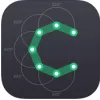Take a look inside 5 images
Choreo Graph
Pros: Most kids will find this arts-meets-math creation tool engaging (and silly), and coordinating lessons support learning.
Cons: It's probable that kids will design without understanding, and certain products (synchronized dog surfing) are only doable with significant forethought.
Bottom Line: Teachers and classroom communities are needed for app activities to meet their learning potential; start with the coordinating lessons.
Head to the NYSCI website, explore the Choreo Graph lessons, and take your pick. You might open your middle school or high school geometry unit with Create a Dance Move, launching students into tangible (and entertaining) practice with angle measurement, angle rotation, and using coordinate pairs to describe the position and translation of objects. Use the student worksheets and add a quick teacher check to ensure planning is completed before app use. Place students in groups of mixed expertise to support peer teaching, or differentiate groups by ability and use other lesson ideas as extensions. Also, middle school teachers should consider Traveling Distances as a cross-curricular physics-and-geometry opportunity, since the lesson brings together the Pythagorean theorem and distance formulas.
Teachers may want to prep students, especially big dreamers, short fuses, and perfectionists: Finger-tracing images to clip them makes creations choppy (and silly!), and there's a learning curve to getting the touch just right.
Choreo Graph allows students to animate images by rotating angles and translating objects. From the home screen, start with the quick Intro (top right) or choose "Make Some Moves" to begin creating. In Build mode, users take or choose a photo (from the iPad's camera roll or a few preloaded backgrounds) and simply draw on the image to cut out parts. Multiple parts from several photos can be used in a project. Each clipped piece has a bull's-eye for use in Animate mode. Users can move points on a graph to control angles of moving parts and can drag objects to new locations. These moves can be set to music.
"Tell the Story" allows for report writing, though the templates include only text/media boxes (no prompts). Classroom use is easy: There are no student accounts, and the app runs (mostly) without internet. Students can upload work to a teacher hub (via a NYSCI-based teacher account) with a code.
Choreo Graph’s build-and-animate features have an awesome fun factor, and most students will figure out the basics in no time. There are, however, some drawbacks. First, students who dive in will need to backpedal as they better figure out their plan -- ack, they actually wanted it on a beach (not a field), and the ball should start to the right, not left. Large mid-project modifications will feel more like redoing than tweaking. Second, though the angle measures and coordinates are visible, app play alone won't lead to learning.
Amazingly, NYSCI has 6 Choreo Graph lesson plans that address both of these concerns. Student-facing worksheets provide time and space for pre-app planning. Further, activity prompts and reflection questions help students and teachers focus on understanding content and engaging in valuable class dialogue.













